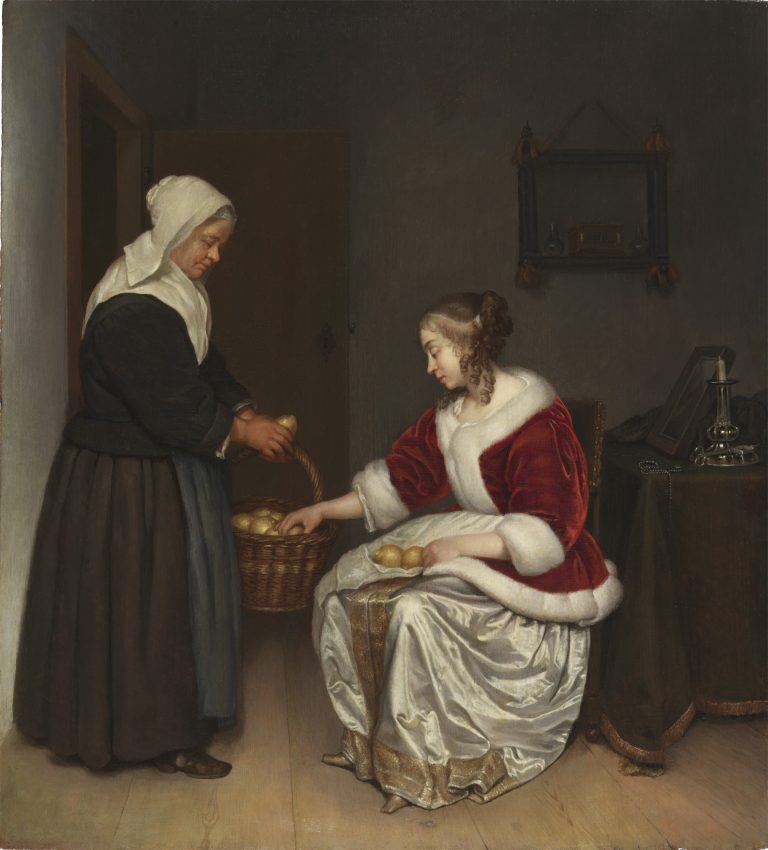Caspar Netscher’s elegant depiction of a woman selecting lemons offers a twist on the familiar theme of a woman supervising her maid. The popularity of the subject in Dutch painting was linked to the exhortations of Jacob Cats and others regarding the housewife’s pivotal role in the smooth running of the household.1 One of the primary responsibilities of a seventeenth-century Dutch housewife, according to Cats, was to ensure that her family was properly fed and provided for, whether she dispatched those duties herself or delegated them to a maidservant. Domestic manuals such as Cats’s Houwelyck (Marriage) emphasized the importance of shopping wisely, obtaining the best quality food for the family without squandering the household purse. Images of women shopping for foodstuffs or interacting with vendors became increasingly popular from the 1640s onward in the hands of artists such as Quiringh van Brekelenkam (after 1622–ca. 1669), Jacob Ochtervelt (1634–82), Pieter de Hooch (1629–84), and others. Some depict the mistress of the house shopping in the marketplace or negotiating with vendors at the door to the family home (fig 1) (see also GM-114); others emphasize the housewife’s pedagogical and managerial skills, showing her expertise by inspecting the goods selected by her maid (fig 2). Many of these interactions feature fish or soft fruits, perishable foodstuffs that tested a woman’s skill in evaluating freshness and quality.
Most of these depictions are set in the voorhuis (front foyer) or courtyard of the home, or include a view to the outside, drawing attention to the role of commerce as a platform for interaction between the private realm and the outside world. By contrast, Netscher’s Two Women in an Interior with a Basket of Lemons takes place within a cloistered room: although there is a doorway, it offers no visible route to—or interference from—the outside world. The exchange between the women seems designed not so much to show off the young woman’s domestic competence as to draw attention to her graceful gestures and stylish garments. Moreover, while Brekelenkam’s and Ochtervelt’s housewives typically have set aside sewing, childcare, or some other worthy domestic chore in order to attend to the maid or vendor, Netscher’s pretty protagonist shows no evidence of having been so industriously occupied. Indeed, the only objects on the table beside her are a heavy silver candlestick, a mirror, a pearl necklace, and a crumpled cloth, while a decorative shelf hanging on the wall behind holds a gilded casket and two glass flasks: all objects that can be linked to the vanities of a woman’s toilette.
In the seventeenth century, lemons and citrons were luxury items, imported to the Netherlands from the Mediterranean at considerable effort and expense. Their astringency was used to temper the sweetness of wine, or to balance the “moist humors” and “cold slime” of oysters. In paintings, lemons often functioned as symbols of temperance and moderation; or, prompted by the contrast between their external beauty and the tart flesh within, as warnings against sinful behavior.2 It is by no means certain that Netscher invested his painting with such associations. Nevertheless, by having the woman select lemons—rather than some more essential foodstuff, or one that might require particularly keen judgment—Netscher underscores her pampered situation. This is all the more apparent when Two Women in an Interior with a Basket of Lemons is juxtaposed with a slightly earlier and far humbler depiction of the same older woman as a fruit vendor (fig 3), this time selling cherries in an outdoor market to a young girl who receives the bright fruit in her bunched-up apron.3
